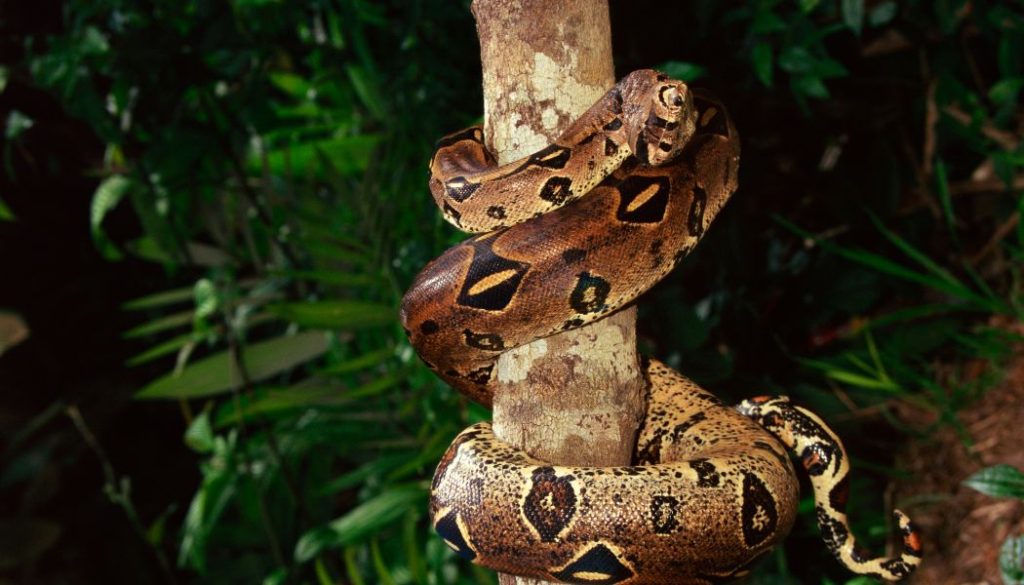Absolutely, red tail boas do like to climb, though they’re not strictly arboreal. In their natural habitats, ranging from tropical forests to arid regions, they’re opportunistic climbers. They might not scale trees like some species, but they’re known to explore branches, rocks, and other elevated structures.
In this article, we’re diving deep into the climbing habits of these fascinating creatures.
We’ll debunk common myths, explore their natural habitats, and even get into the nitty-gritty of snake anatomy that makes them adept (or not) at climbing.
We’ll also delve into the health benefits, risks, and ways to encourage your red tail boa to reach new heights. Ready to elevate your snake knowledge? Let’s go!

Table of Contents
- 1 Common Myths About Red Tail Boas and Climbing
- 2 Natural Habitats of Red Tail Boas: Do They Climb in the Wild?
- 3 The Anatomy of Climbing: What Makes a Snake Good at It?
- 4 The Health Benefits of Climbing for Red Tail Boas
- 5 Risks and Precautions When Providing Climbing Structures
- 6 How to Encourage Your Red Tail Boa to Climb
- 7 Conclusion
- 8 FAQ
Common Myths About Red Tail Boas and Climbing
Before we get to the juicy facts, let’s debunk some of the myths that have slithered their way into popular consciousness.
Myth 1: Red Tail Boas Are Strictly Ground Dwellers
First on the chopping block is the enduring myth that red tail boas are strictly terrestrial creatures that never climb. Now, while it’s true that these snakes are not arboreal like some other species (think of green tree pythons), they’re not exactly homebodies who never venture upward.
In their natural habitats, which range from jungles to semi-arid regions, red tail boas have been observed climbing shrubs, trees, and rocks. Think about it; their natural environment isn’t a flat, featureless plane. Why should their captive environment be any different?
Myth 2: Climbing Is Dangerous for Red Tail Boas
Myth number two is the idea that climbing is downright hazardous for red tail boas. While it’s true that you need to be cautious about the types of climbing structures you introduce (safety first, people!), the act of climbing itself is not inherently dangerous.
In fact, it can be beneficial for their health, offering mental stimulation and physical exercise. So, unless you’re giving your boa a vertical wall slicked with oil, climbing is not the perilous activity some make it out to be. Just be smart about the materials and stability of any climbing structures.
Myth 3: They Don’t Need Vertical Space in Their Enclosures
Last but certainly not least is the myth that red tail boas don’t need any vertical space in their enclosures. Let’s squash this one like a bug—figuratively, of course.
An enclosure that mimics a snake’s natural habitat, including vertical elements, not only adds aesthetic value but also contributes to the snake’s overall well-being. We’ve all heard of cage enrichment for mammals and birds, right?
Well, snakes are no different. They too deserve a rich, stimulating environment, and that includes vertical space for climbing.
Natural Habitats of Red Tail Boas: Do They Climb in the Wild?
Geographic Diversity: From Rainforests to Arid Lands
Hold onto your seats because we’re going on a geographical journey! Let’s jet-set to the natural habitats of red tail boas, which are as diverse as the colors on their stunning scales.
From the tropical rainforests of Central and South America to drier, more semi-arid regions, these snakes are versatile, to say the least. But here’s the million-dollar question: do they climb in the wild?
Opportunists, Not Specialists: Climbing in Lush Environments
First off, it’s important to know that red tail boas are not specialists; they’re opportunists. These adaptable creatures will take advantage of what their environment offers. In lush, vegetative areas, for instance, they’ve been observed lounging on tree branches or winding their way up vines.
They won’t go as high as some of the truly arboreal snakes, but they aren’t afraid of a little elevation either. The vertical world is part of their natural vocabulary, so to speak.
Rocks, Boulders, and Bushes: Climbing in Arid Terrains
Now, let’s zoom into the arid regions. Here, climbing isn’t about trees; it’s about rocks, boulders, and sometimes even scrubby bushes. The climbing they do in these habitats is generally lower to the ground but climbing nonetheless.
The Final Verdict: Embracing Their Inner Climber
The verdict? While they’re not what you’d call tree-huggers, red tail boas in the wild do climb to some extent depending on their environment.
So, if you think your pet boa only likes to stick to the ground, think again. Chances are, given the opportunity, it would embrace its inner climber, just like its wild cousins.
The Anatomy of Climbing: What Makes a Snake Good at It?
Muscle Structure: The Engine Room of Climbing
Let’s kick things off with what’s beneath the skin—muscle structure. Red tail boas have strong, robust muscles that wrap around their entire body, allowing them to constrict their prey, yes, but also giving them the raw power needed for climbing. This musculature isn’t just for show; it’s functional and versatile.
Scales and Their Role: The Grip Masters
Now let’s chat about those iconic scales. Besides looking cool, scales actually play a crucial role in climbing. The underside of a red tail boa has specialized belly scales that grip surfaces, providing the traction needed to move upward. It’s like having built-in climbing shoes!
Other Physical Features Like the Tail: The Unsung Hero
Last but not least, let’s give a shout-out to the tail. You might think it’s just there for the looks, but that tail plays a pivotal role in balance and maneuverability when climbing. It’s the rudder that steers the ship.
The Health Benefits of Climbing for Red Tail Boas
Exercise and Muscle Tone: More than Just Ssssssthetics
Physical fitness isn’t just for us humans. Climbing offers red tail boas an excellent form of exercise, helping maintain muscle tone. A toned snake is a happy snake. Think of it as their gym routine, minus the obnoxious gym selfies.
Mental Stimulation: Snakes Need Fun, Too
You might not think of a snake as needing mental stimulation, but these are complex creatures. Offering them a variety of climbing structures can engage their curiosity and enrich their day-to-day lives. A bored snake is more likely to become stressed, and we don’t want that, do we?
Preventing Obesity and Other Health Issues: The Wellness Factor
Let’s talk turkey—uh, snake. A snake that doesn’t move much is a snake at risk for health problems like obesity. Incorporating climbing into their routine can help regulate weight and contribute to overall wellness.
Risks and Precautions When Providing Climbing Structures
Risk of Falling: It’s Not All Rainbows and Butterflies
Let’s not sugarcoat it; there’s always a risk of falling when you allow your red tail boa to climb. But don’t worry, with some smart planning, you can minimize this risk. Just make sure that any climbing structure is stable and secure. After all, a wobbly branch is a recipe for disaster!
Material Considerations: Safety First, Always
When it comes to choosing materials for climbing structures, make no compromises. Opt for non-toxic and splinter-free options like PVC or sanitized natural wood. Steer clear of materials that could be harmful if ingested or might cause skin irritation.
Best Practices for Setting Up and Securing Structures: Do It Right
Secure those climbing structures tightly to the enclosure, folks. We’re talking screws, clamps, or heavy-duty zip ties. Regularly check for wear and tear and replace anything that’s started to deteriorate. No cutting corners on safety!
How to Encourage Your Red Tail Boa to Climb
Step-By-Step Guide on Introducing Climbing Structures: Roll Out the Red Carpet
Begin by introducing one climbing structure at a time. Place it in the enclosure and let your snake explore at its own pace. Gradually add more complexity, like branches or shelves, as your snake becomes comfortable.
Tips and Tricks for Making the Process Enjoyable for Your Snake: Spice It Up!
Consider spraying the climbing structure lightly with water or adding some foliage to mimic a natural environment. The key here is to make the setup as inviting as possible. Think of it as setting the mood for a fun climbing session.
Signs That Your Red Tail Boa Enjoys Climbing: The Tell-Tale Signs
How do you know your red tail boa is into climbing? Well, if they spend more time off the ground, explore new heights, and generally look more active, you’ve got yourself a climber! Also, less stress and a healthier-looking physique are good indicators that your snake is enjoying the vertical life.
Conclusion
We’ve debunked myths, explored their natural habitats, and dug into the anatomy that supports their climbing endeavors. You’ve also learned about the health benefits and the importance of safe climbing setups.
The takeaway? Your red tail boa is more versatile and adaptable than you might have thought. So go ahead, enrich their living space with some vertical opportunities.
It’s not just about making their home look good; it’s about enhancing their quality of life. Get climbing!
FAQ
Do Boas Need Climbing Space?
The quick and dirty answer? Yes, they do! While they’re not what you’d call “tree-huggers,” they still appreciate some vertical real estate. It’s all about offering variety and mental stimulation. A few branches or a climbing structure can add a world of difference to your red tail boa’s life.
Is the Red Tail Boa Arboreal?
Nah, not really. They’re not strictly arboreal like some other snake species, but they’re not afraid to climb if the opportunity arises. So while they won’t be swinging from the trees like Tarzan, they’re not exactly groundhogs either.
What Do Boas Like in Their Cage?
Ah, the million-dollar question! Red tail boas are pretty low-maintenance but appreciate a well-designed cage. A hide box for privacy, a water dish for hydration, and yes, a climbing structure for that sweet, sweet exercise.
Do Red Tail Boas Like to Hide?
You bet they do! Hiding is a natural behavior that offers a sense of security. So make sure to provide a cozy hideout where your snake can retreat and feel safe. It’s like their own little snake cave!




0 Comments